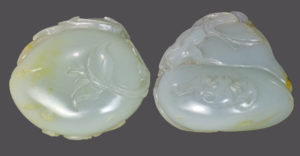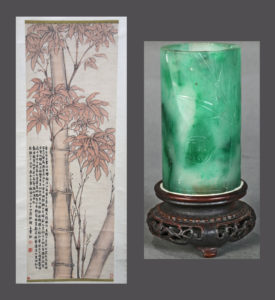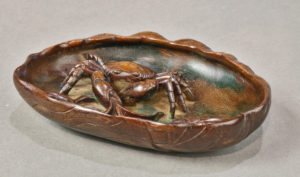Chinese art is deeply embedded with auspicious motifs believed to bring good fortune. If ‘seeing is believing’, the Chinese took such positive energy and expressed it in visual form from folk to fine art. Such auspiciousness was not only self consumed, but when shared as gifts, the receiver is accepting the giver’s well wishes. Due to the large amount of homonyms in the Chinese language, many rebuses are based on the play of words transformed visually. Besides pun, inherent and natural qualities of certain items are also weighted in this tradition of symbolism. The lexicon of this matter is large, especially when symbols can be interchanged and compounded to create various combinations. Only three will be discussed at this time.
Bamboo:
The bamboo grows tall and straight, flexible in the wind, but does not easily break due to its nature of having hollow sections alternated with notches. It is one of the four plants often used to symbolize the ideal gentlemen who holds high moral integrity. In addition, bamboo is pronounced ‘zu’ which is a homonym with the term ‘to wish’. When it is combined with a bat, a homonym of the Chinese character ‘fu’, it means ‘wish you prosperity’. In the same way, bamboo can be paired with other auspicious symbols to create other well wishes. There is another popular Chinese phrase ‘zu bao ping an’ (bamboo announces peace), therefore bamboo is also associated with peace and harmony.

Chinese jade toggle, carved with the Three Auspicious Fruits, peach, pomegranate and Buddha hand citron, accented by a bat.
Three Abundances:
The three auspicious fruits include the Buddha hand citron, peach and pomegranate; representing the term ‘fu shou san duo’ (three abundances of prosperity, longevity and fertility). The Buddha hand citron is a homonym with the term ‘fu’ (prosperity); the peach is associated with longevity and the pomegranate is associated with fertility because it bears a large amount of seeds. Sometimes, a bat can be added as well to amplify the matter since as mentioned it is also pronounced ‘fu’.
Crab:
Another common motif on a scholar’s item is the crab. It is related to success in the highly regarded civil service examination, because the armor form crab shell ‘jia’ is a homonym with ‘rank’. One crab symbolizes that one will rank first in the civil service exam. And if aspirations are not as high, two crabs with reeds represents that one will be announced to rank in the second class of candidates, which are the fourth through the tenth place.

